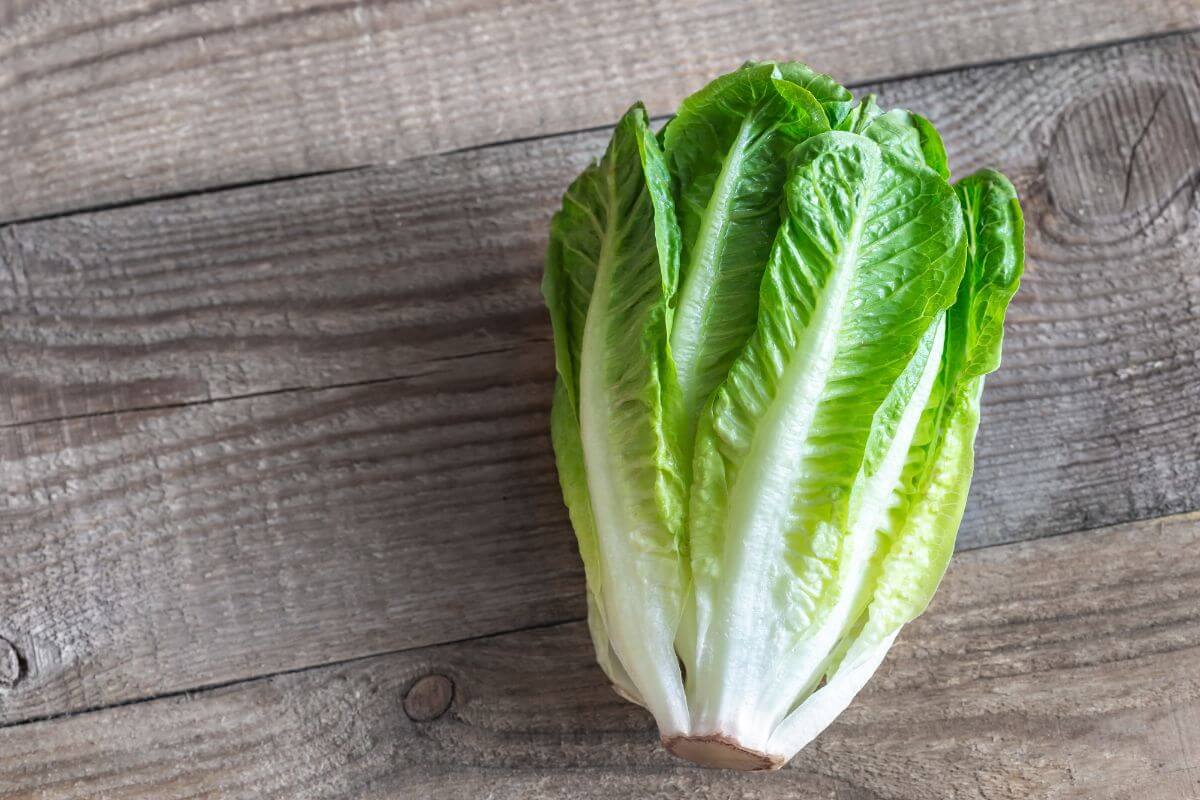Is lettuce a fruit or vegetable? You might be surprised to learn that this common salad ingredient sparks debate. Let’s dive into the facts to settle this once and for all.
Lettuce is a vegetable, not a fruit. It comes from the leaves of the lettuce plant, unlike fruits that grow from the ovary of a flowering plant and contain seeds. In this article, we’ll explore why lettuce is classified as a vegetable and how it’s used in cooking.
Curious about the different types of lettuce and their health benefits? Keep reading to discover everything you need to know about this versatile leafy green.
- Related article: Fruit and Vegetable Comparison
5 Key Takeaways on Is Lettuce a Fruit or Vegetable
- Lettuce is a vegetable because it comes from the leaves of the lettuce plant, Lactuca sativa. It doesn’t grow from the ovary of a flowering plant and it doesn’t have seeds like fruits.
- Lettuce has a high water content. About 95% of it is water. This is much higher than other leafy vegetables, which have around 80% water.
- In the kitchen, lettuce is used in savory dishes. You’ll find it in salads, wraps, and sandwiches. Its mild, watery taste isn’t sweet like fruits.
- There are four main types of lettuce. These are Crisphead, Butterhead, Looseleaf, and Romaine. Each type has unique characteristics in leaf texture, flavor, and structure.
- The nutritional value of lettuce varies by type. Romaine and leaf lettuces provide more vitamins A and K. Crisphead (Iceberg) lettuce has fewer nutrients. Butterhead lettuce offers a moderate amount of vitamins.
Is Lettuce a Fruit or Vegetable?

Lettuce is a vegetable that contains about 95% water — other leafy vegetables have around 80%. It comes from the leaves of the lettuce plant (Lactuca sativa). True fruits grow from the ovary of a flowering plant and have seeds. Lettuce leaves do not meet this definition.
In the kitchen, lettuce is used as a vegetable. You often find it in savory dishes and salads. Fruits are usually sweet and eaten alone or in desserts. On the other hand, lettuce has a mild, watery taste and is not sweet.
The lettuce leaves are used in salads, wraps, and sandwiches to name a few. Historically, it was also used as medicine. When preparing salads, cucumbers are a great pair to lettuce. Their crisp texture and mild flavor complement a variety of vegetables, making your salad refreshing and delicious.
- Learn more: Is the Cucumber Really a Vegetable or a Fruit?
If you want to grow your own, planting lettuce seeds is a good start.
Comparing the Four Main Types of Lettuce
Lettuce comes in many varieties, but they all fit into four main types. Each type has unique traits like leaf texture, flavor, and how tightly the leaves grow together. Here’s an overview:
| Type of Lettuce | Characteristics | Flavor/Taste | Examples |
|---|---|---|---|
| Crisphead Lettuce | Forms tight, round heads with crisp, crunchy leaves | Mild, slightly sweet | Iceberg lettuce |
| Butterhead Lettuce | Forms loose, rounded heads with smooth, tender leaves | Soft, buttery texture | Boston lettuce, Bibb lettuce |
| Looseleaf Lettuce | Leaves are loosely arranged, not forming a tight head | Mild, often sweet | Green leaf lettuce, Red leaf lettuce, Oak leaf lettuce |
| Romaine Lettuce | Forms tall, elongated heads with sturdy, crisp leaves | Slightly bitter | Romaine (Cos) lettuce, Little Gem lettuce |
There is also asparagus lettuce, which doesn’t belong to any of the four main types. It has a unique, large stem and a special flavor.
Nutritional Content of the Four Main Lettuce Types
Here are the key nutritional details for the four main lettuce types:
| Type of Lettuce | Calories (per cup) | Protein (per cup) | Fiber (per cup) | Vitamin A (% daily value per cup) | Vitamin K (% daily value per cup) | Vitamin C |
|---|---|---|---|---|---|---|
| Crisphead (e.g. Iceberg) | 10 | 1 gram | 1 gram | 7% | 20% | – |
| Butterhead (e.g. Boston, Bibb) | 7 | 1 gram | 1 gram | 36% | – | small amounts |
| Looseleaf (e.g. Green Leaf, Red Leaf) | 4-5 | 0-1 gram | 0-1 gram | 42% (red leaf) | – | small amounts |
| Romaine | 8 | 1 gram | 1 gram | 82% | high amounts | – |
Romaine and leaf lettuces have more vitamins A and K. Crisphead (iceberg) lettuce has fewer nutrients. The butterhead lettuce variety has a moderate amount of vitamins.
What Are the Health Benefits of Lettuce?

Lettuce is a fantastic vegetable. It gives your body key nutrients like vitamin A, which boosts your immune system. It also has vitamins C and K and folate.
Green leafy vegetables are packed with antioxidants. Here are some impressive health benefits of eating lettuce. Remember that the benefits of lettuce vary based on how you include it in your diet.
1. Lettuce Has Potential Anti-Inflammatory Properties
Lettuce isn’t just for salads, it’s a health booster. This leafy green is full of antioxidants and offers vitamin C, vitamin K, and carotenoids that fight inflammation.
Animal studies show that lettuce can block enzymes like lipoxygenase that trigger inflammation. This power comes from unique compounds like lactucin and lactucopicrin.
Eating more lettuce can help control inflammation because of its special mix of vitamins and antioxidants. Whether in a Caesar salad or a garden mix, lettuce adds a strong health kick to your meals.
2. Lettuce Lowers Cholesterol Levels
Eating lettuce can do wonders for your health, especially when it comes to keeping your cholesterol in check.
Studies on animals have shown that adding this crisp, leafy green to your diet can significantly lower your LDL (bad) cholesterol. Why? It’s all thanks to the fantastic mix of fiber, plant sterols, and antioxidants packed in each leaf.
Here’s the simple truth: making lettuce a regular part of your meals is a deliciously easy way to support your heart and overall health.
3. Lettuce May Promote Better Sleep
Lettuce isn’t just for salads, it also has a hidden talent as a sleep aid. This leafy green contains lactucarium, a natural compound that can help you relax. Think of it as nature’s way of calming you down, without the side effects of opium.
Research on animals shows that lettuce extract with lactucarium can lower heart rate and reduce the urge to move. This is a strong hint that lettuce might be a gentle, natural remedy for sleep problems. The way lactucarium works is by quieting down the signals in your brain that keep you alert, much like how diazepam works.
4. Lettuce May Help Relieve Anxiety
Research on animals shows that lettuce extracts might reduce anxiety. Compounds like lactucin and lactucopicrin could be why lettuce has calming effects. Eating lettuce often might help with mild anxiety, but more studies on humans are needed.
5. Lettuce Supports Eye Health

You might not know this, but romaine and other dark leafy lettuces are great for your eyes. They have antioxidants like lutein and zeaxanthin that protect your vision. Plus, the vitamin A in lettuce helps keep your eyes healthy and prevents age-related macular degeneration.
Eating lettuce often can also lower your risk of cataracts and other eye diseases. Next time you’re making a salad, think about how it’s not just tasty but also good for your eyes!
6. Lettuce Provides Good Hydration
Lettuce is mostly water, with over 95% of its weight coming from water. This high water content is great for keeping you hydrated.
Eating lettuce can be a tasty way to increase how much water you get each day. Plus, because it’s so full of water, it helps you feel full. That means it can stop you from feeling super hungry between your regular meals.
Being well-hydrated is key to making sure your body works the way it should. Adding lettuce to your meals is an easy way to stay hydrated and support your overall health.
7. Lettuce Supports Bone Strength
Lettuce is a great source of vitamin K, a vital nutrient for keeping our bones healthy. This vitamin is essential for managing how our bodies use calcium, the key to bone strength. By adding vitamin K-rich lettuce to your diet often, you’re helping to fend off osteoporosis and fractures.
So, if you’re looking to boost your bone health deliciously, a salad with plenty of lettuce is a great choice.
Different Ways to Add Lettuce to Your Diet

Here are some ways you can add lettuce to your everyday meals:
- Salads – Use different lettuces like romaine, leaf lettuce, or butterhead. Mix in veggies, proteins, fruits, nuts, and dressings for a complete meal.
- Lettuce Wraps – Large leaves like romaine or butter lettuce make great low-carb wraps for chicken, tofu, or beans. Serve as a main dish or appetizer.
- Soups – Add chopped lettuce to vegetable or broth-based soups. Lettuce soup is light and refreshing.
- Juices and Smoothies – Add romaine or leaf lettuce to vegetable juices or smoothies. It hydrates and adds fiber and vitamins without changing the taste much.
- Sautéed or Grilled – Sauté or grill lettuce leaves quickly. This brings out their natural sweetness. Serve as a side dish or use in recipes.
- Lettuce Cups/Boats – Use leaves as low-calorie vessels for fillings like chicken salad, tuna, or veggies.
- Layered in Sandwiches and Wraps – Add crisp leaves to sandwiches, burgers, and wraps for freshness and crunch.
- Pasta and Rice Dishes – Toss chopped lettuce into pasta, rice bowls, or grain dishes for extra nutrition and texture.
Experiment with different types and methods to easily include this versatile vegetable in your diet.
Is Lettuce Fruit or Vegetable? Final Thoughts
Lettuce is an easy and nutritious way to boost your veggie intake. Its leaves are full of water and nutrients that your body needs.
When shopping for lettuce, look for organic options. Avoid those grown with harmful pesticides because even after washing, some chemicals might linger on the leaves.
The best way to enjoy lettuce is in salads. You can also add shredded lettuce to sandwiches, wraps, and burgers for extra crunch and nutrition.
Is Lettuce a Fruit or Vegetable FAQs
1. Is Lettuce Technically a Fruit?
No, lettuce is technically not a fruit. It is specifically a leafy vegetable — a category where the plant leaves are eaten, accompanied occasionally by tender petioles and shoots.
2. Does Lettuce Count as a Vegetable?
Yes, lettuce is a vegetable. To be more accurate, it is categorized as a leafy vegetable.
3. Is a Salad a Fruit or a Vegetable?
A green salad, also called a garden salad, usually has leafy vegetables like lettuce, spinach, or arugula.
For more on different foods and whether they are fruits or vegetables, check out these articles:

